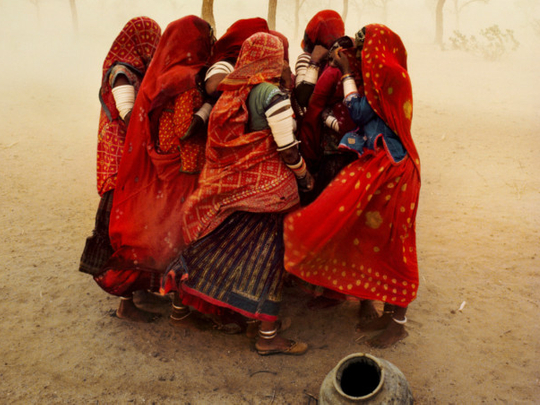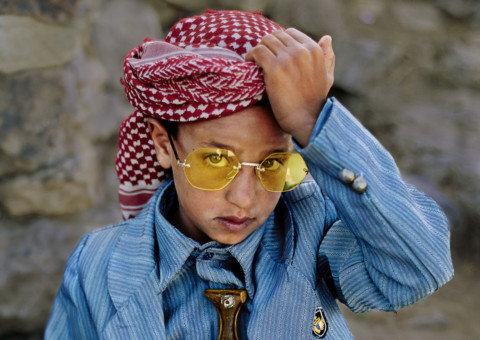
Steve McCurry has been one of the most iconic voices in contemporary photography over the last three decades.
The American photojournalist is best known for his portrait of “the Afghan Girl” that originally appeared on the cover of National Geographic magazine’s June 1985 issue and has been voted the most recognised photograph in the history of the magazine.
McCurry was among the first photographers to travel to the rebel-controlled areas of Afghanistan just before the Soviet invasion and his coverage of the conflict won him the Robert Capa Gold Medal, awarded to photographers exhibiting exceptional courage and enterprise.
Since then he has covered several conflicts such as the Iran-Iraq War, the civil wars in Lebanon and Cambodia, and the Gulf War. And he has travelled around the world documenting humanity in times of war and peace.
His work has been published in various magazines and books, offering rare glimpses of human existence in some of the most challenging environments. McCurry has also written several books and held exhibitions of his work. He is a recipient of numerous prestigious awards, including an unprecedented four first-place awards from the World Press Photo contest.
He was in Dubai for the opening of an exhibition titled “Unguarded Moments”, featuring 36 of his amazing photographs. “Most of my images are grounded in people. I look for the unguarded moment, the essential soul peeking out, experience etched on a person’s face. I try to convey what it is like to be that person, a person caught in a broader landscape, that you could call the human condition,” he said.
Despite his fame and success, McCurry is an unassuming person who enjoys talking to people and sharing his experiences.
He spoke to Weekend Review about his work, his fascination with the East and “that” famous picture. Excerpts:
After studying filmmaking, why did you choose to become a photographer?
I prefer photography because it is immediate and spontaneous. But my main motivation for becoming a photographer was that I wanted to see the whole world, experience different cultures and landscapes, and this is a good way to do that and get paid for it too.
What is the reason for your enduring interest in India?
I first planned a trip to India because I had already done assignments in Africa, Latin America and Europe and wanted to go to a new place, especially in Asia. I chose India because culturally, it is the richest. In one country you have so much variety in terms of religions, ancient traditions, festivals and geography.
The trip was supposed to be for six weeks, but I ended up staying for two years because there were so many interesting stories to do. Since then I have gone back more than 80 times and have done stories on the monsoon, on train journeys, on Mumbai and many others.
In terms of visual richness, my favourite places in India are Rajasthan, Gujarat, Ladakh and Kolkata. I have seen how India is changing. Earlier, in places such as Rajasthan and Gujarat, men wore colourful turbans and dhotis and women wore handwoven, locally produced fabrics. But now they wear synthetic Chinese fabrics and the men wear turbans only on special occasions. The tradition and what was unique to that place is vanishing fast.
How do you decide what pictures to take?
I respond to a situation, action or sight that inspires me. And I hope that other people will be as moved by these scenes as I was and that my pictures will stand the test of time. Sometimes it is quick, such as the picture of the Rajasthani women in the storm. I was passing by and saw them huddling under a tree and just jumped out of the car and took the picture without them even noticing me. But sometimes you have to wait for the right moment, like I did with the Afghan girl.
Did you feel that the photograph of the Afghan girl would be so special? What made you want to go back to look for her? And has being on the cover of National Geographic helped her in any way?
I saw Sharbat Gula in a school in a refugee camp in Peshawar in 1984 and was struck by her piercing eyes, but she was shy and covered her face. I had to spend some time making her feel relaxed before I could get that direct look into the camera just for a few seconds. But I knew right away that this picture was special.
We went back in 2002 and tried to find her because we were curious to know how she was and wanted to do something good for her. It was difficult because I did not even know her name and many women claimed to be her in the hope of getting money from us. But we miraculously found her. She remembered me because I was probably the first foreigner she had met and it was the only time she had been photographed. By then, she was married and had children, and had no idea how famous she was. We are happy that we have been able to help her and her family.
What motivated you to risk your life in places such as Afghanistan and Iraq?
These are calculated risks and I am always careful in these situations. But it is essential for journalists and photographers to keep the world informed about what is happening in the world we live in.
Going to areas in conflict has taught me so much about human behaviour, because you get to see how people behave in situations where all the superficial things in life become unimportant and one is fighting for fundamental things like one’s country, village or family. But I have moved on and don’t do that kind of work anymore.
How do you feel about the fact that a lot of the history of our times will be told through your photographs?
It feels great, but I don’t think of that when I am taking the pictures. I am just fascinated with cultures that are unique and indigenous. For instance, in Rajasthan, the architecture, the folk music, the food, the local dialects and even the way the turban is tied in different regions took thousands of years to evolve. But, now, all that is being lost so quickly. So, my pictures are a historical document of the way we were, and of unique cultures that are now vanishing.
The 2013 Pirelli calendar is quite a departure from your work so far. What made you take this on?
I accepted it because it this is one of the great photographic assignments in the world. But I did it my way. I chose models (including one who was pregnant) who are deeply involved in humanitarian activities because I wanted to focus on people and charities who are trying to make the world a better place. I photographed them all fully clothed because I wanted to show them as real people.
What are the present projects you are working on?
During the last 30 years I have travelled all over Asia photographing the Buddhist world, its culture and practitioners. And I am now working on a story on Buddhism around the world and will travel to Burma (Myanmar) and India in early 2013.
How come you have never felt inspired by your own country?
There is no good explanation for this, but I am just more fascinated with places such as India and Burma than I am with the United States. But I have done some projects in the US and plan to do some more soon.
“Unguarded Moments” will run at The Empty Quarter gallery till January 10.



